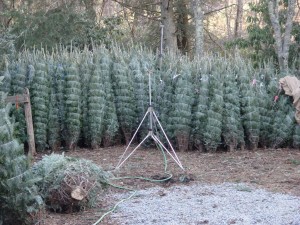When Was Your Tree Cut?
go.ncsu.edu/readext?293048
en Español / em Português
El inglés es el idioma de control de esta página. En la medida en que haya algún conflicto entre la traducción al inglés y la traducción, el inglés prevalece.
Al hacer clic en el enlace de traducción se activa un servicio de traducción gratuito para convertir la página al español. Al igual que con cualquier traducción por Internet, la conversión no es sensible al contexto y puede que no traduzca el texto en su significado original. NC State Extension no garantiza la exactitud del texto traducido. Por favor, tenga en cuenta que algunas aplicaciones y/o servicios pueden no funcionar como se espera cuando se traducen.
Português
Inglês é o idioma de controle desta página. Na medida que haja algum conflito entre o texto original em Inglês e a tradução, o Inglês prevalece.
Ao clicar no link de tradução, um serviço gratuito de tradução será ativado para converter a página para o Português. Como em qualquer tradução pela internet, a conversão não é sensivel ao contexto e pode não ocorrer a tradução para o significado orginal. O serviço de Extensão da Carolina do Norte (NC State Extension) não garante a exatidão do texto traduzido. Por favor, observe que algumas funções ou serviços podem não funcionar como esperado após a tradução.
English
English is the controlling language of this page. To the extent there is any conflict between the English text and the translation, English controls.
Clicking on the translation link activates a free translation service to convert the page to Spanish. As with any Internet translation, the conversion is not context-sensitive and may not translate the text to its original meaning. NC State Extension does not guarantee the accuracy of the translated text. Please note that some applications and/or services may not function as expected when translated.
Collapse ▲Freshness, Fire Safety and Your Tree
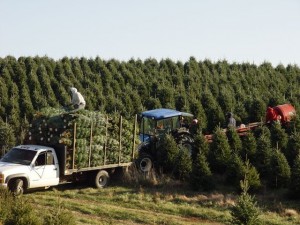
A good Christmas tree grower will quickly cut and bale trees and take them to a storage facility.
When was this tree cut? It could be an important question in some situations, but is just as likely to be meaningless. After all, you don’t ask the grocery store clerk when the cow was milked, you read the expiration date on a gallon of milk. Christmas trees that were properly handled and kept in cold storage on the farm for weeks prior to shipment will retain their moisture and stay as fresh as when they were cut. Conversely if a recently cut tree is left in full sun or wind without a provision for water, it will dry out. A cut tree can lose up to half its water in a single day if abused in such a way. Christmas tree freshness is more about the quality of care than the duration.
A Fresh Tree Is A Moist Tree
Why does freshness matter? A fresh tree is full of water. A fresh tree will not burn even when exposed to a flame or spark. (For a video showing the difference in burning potential for a dry tree vs. a well watered tree produced by the National Fire Protection Association (NFPA) and the Underwriters Laboratory (UL) see: Christmas Tree Fire). If you start out with a fresh tree which you, the homeowner, maintain through proper displaying, chances are that tree will remain beautiful throughout the holiday season.
Learning to Identify a Fresh Tree
There is no quick answer to the question “how fresh is this tree?” On the retail lot, it is a matter of observing several subjective factors related to tree care.
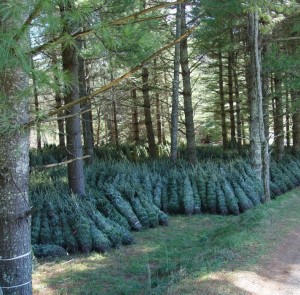
Some Christmas tree growers use the natural shade of white pines or other trees to create a cool storage area.
- Are the trees displayed in water?
- Is the ground or mulch wet from periodic irrigation?
- Are the trees displayed in a shady area?
- Does the store receive multiple tree shipments? The more deliveries the better because it reflects a later cut date or at least longer (cooler) farm storage.
When you examine an individual tree you can also look for several characteristics.
- Is the tree heavy? If it is, it is probably heavy with water.
- Is the foliage cool to the touch? Again, a cool tree is a moist tree. A dried out tree will feel hotter.
- Are the needles soft to the touch? A dry tree will have stiff, sharp needles. The exception to this rule are the spruces which naturally have stiff, sharp needles.
- Are the needles a rich, dark-green color? Dry trees are often bleached-out to a lighter olive-green or grey-green.
- Do the needles stay on the tree? This can be misleading as older needles back inside the canopy of the tree closer to the trunk will shed on even a moist tree. However, needle shed on a cut tree should not be extensive and needle loss on the most current growth on the outside of the tree indicates a problem.
- Are the needles fresh? Very fresh needles are will snap when bent like a fresh green bean. Somewhat dry needles have lost their plumpness and will bend rather than break (like a rubbery, stale green bean). These needles will still take up water if provided. These stressed needles are also most likely to naturally drop if the tree is not fully dormant. The driest needles are so brittle and stiff that they easily break when branches are brushed and leave a broken stub on the branch they came from.
- Is the cut stump sticky with sap? Examine the bottom of the tree where it was cut. If the stump is sticky, that’s a good sign that the tree is still fresh.
Keeping Your Real Tree Fresh
You keep your real tree fresh the same way the Christmas tree farmer and retailer did. Keep it in the shade and keep it watered. Follow these tips for maintaining tree freshness.
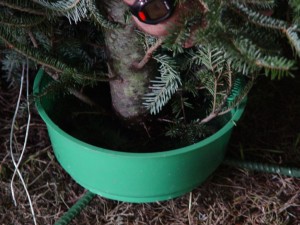
A tree stand that holds a gallon of water will keep your tree fresh throughout the holiday season.
- Cut off at least ½-inch off the trunk of the tree. That is so the tree will take up water easier.
- If you need to store the tree before setting it up in the home, put it in the shade in a bucket of water.
- Have problems with allergies? You might consider washing the tree outside with a garden hose. This will remove any pollen or dust, and will also knock off any dead needles. Allow the tree to dry off completely before bringing it into the home.
- Display the tree in a tree stand that can hold at least a gallon of water. Make sure you check the water level every day to be sure there is enough and that the tree is using water. Dry trees can take a day or two before taking up water. Also trees that were very cold may take some time to take up water again.
- Never add anything to the water. All your real tree needs is fresh water.
- Display the tree away from heat sources. Use lights that are in good working condition that are UL certified. Unplug the lights when you leave the house or go to sleep at night.
- The tree isn’t taking up water? If the tree isn’t decorated, you can put another fresh cut on the stump. If it is, you may be able to create a kind of fresh cut by drilling holes in the trunk below the water line. Some people have gotten their tree to take up additional water by using very hot water, but this testimonial information has not been tested by research methods.
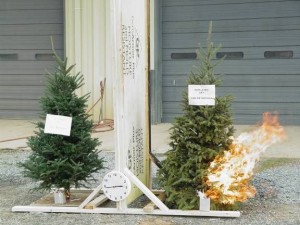
A moist Christmas tree (left) will not burn when exposed to the same flames that caused a dry tree to catch fire (right).
The above listed recommendations were developed for the typical Christmas tree harvested during a normal season. A small percentage of trees may not perform as expected every year. This can result from combinations of factors including the weather during harvest, an individual tree’s genetic predisposition to needle loss, or damage from pests. If you have taken all appropriate steps to care for your tree and you experience abnormal water uptake, needle loss, or drying please contact Jeff Owen, Area Extension Forestry Specialist, NC State University (jeff_owen@ncsu.edu or (828)684-3562).
Written by Jeff Owen and Jill Sidebottom, November, 2011



